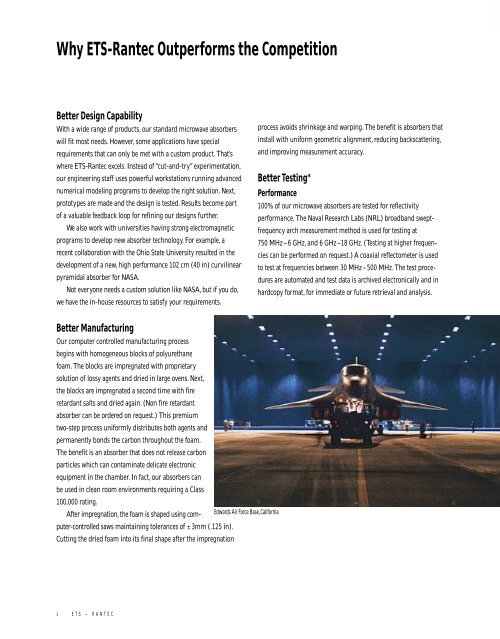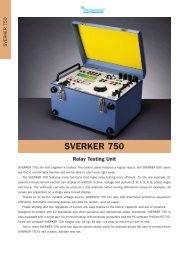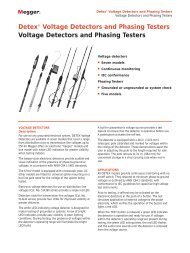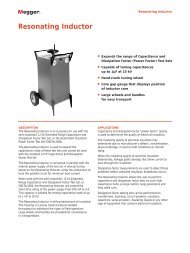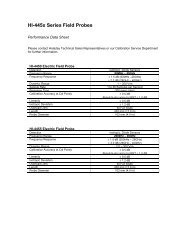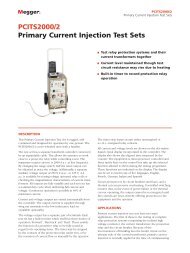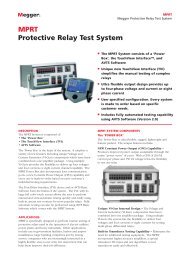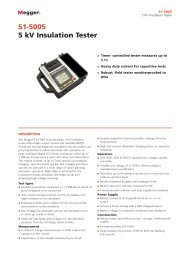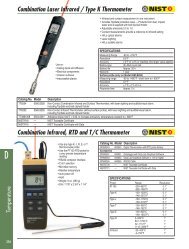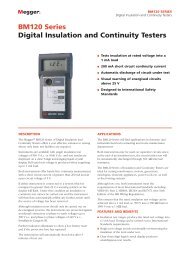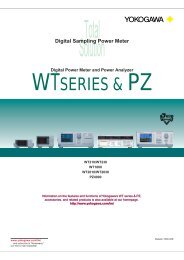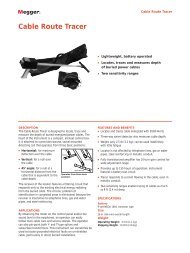Microwave Absorber Selection Guide - Maxtech
Microwave Absorber Selection Guide - Maxtech
Microwave Absorber Selection Guide - Maxtech
Create successful ePaper yourself
Turn your PDF publications into a flip-book with our unique Google optimized e-Paper software.
w<br />
Why ETS-Rantec Outperforms the Competition<br />
Better Design Capability<br />
With a wide range of products, our standard microwave absorbers<br />
will fit most needs. However, some applications have special<br />
requirements that can only be met with a custom product. That’s<br />
where ETS-Rantec excels. Instead of “cut-and-try” experimentation,<br />
our engineering staff uses powerful workstations running advanced<br />
numerical modeling programs to develop the right solution. Next,<br />
prototypes are made and the design is tested. Results become part<br />
of a valuable feedback loop for refining our designs further.<br />
We also work with universities having strong electromagnetic<br />
programs to develop new absorber technology. For example, a<br />
recent collaboration with the Ohio State University resulted in the<br />
development of a new, high performance 102 cm (40 in) curvilinear<br />
pyramidal absorber for NASA.<br />
Not everyone needs a custom solution like NASA, but if you do,<br />
we have the in-house resources to satisfy your requirements.<br />
process avoids shrinkage and warping. The benefit is absorbers that<br />
install with uniform geometric alignment, reducing backscattering,<br />
and improving measurement accuracy.<br />
Better Testing*<br />
Performance<br />
100% of our microwave absorbers are tested for reflectivity<br />
performance. The Naval Research Labs (NRL) broadband sweptfrequency<br />
arch measurement method is used for testing at<br />
750 MHz–6 GHz, and 6 GHz–18 GHz. (Testing at higher frequencies<br />
can be performed on request.) A coaxial reflectometer is used<br />
to test at frequencies between 30 MHz–500 MHz. The test procedures<br />
are automated and test data is archived electronically and in<br />
hardcopy format, for immediate or future retrieval and analysis.<br />
Better Manufacturing<br />
Our computer controlled manufacturing process<br />
begins with homogeneous blocks of polyurethane<br />
foam. The blocks are impregnated with proprietary<br />
solution of lossy agents and dried in large ovens. Next,<br />
the blocks are impregnated a second time with fire<br />
retardant salts and dried again. (Non fire retardant<br />
absorber can be ordered on request.) This premium<br />
two-step process uniformly distributes both agents and<br />
permanently bonds the carbon throughout the foam.<br />
The benefit is an absorber that does not release carbon<br />
particles which can contaminate delicate electronic<br />
equipment in the chamber. In fact, our absorbers can<br />
be used in clean room environments requiring a Class<br />
100,000 rating.<br />
After impregnation, the foam is shaped using computer-controlled<br />
saws maintaining tolerances of ± 3mm (.125 in).<br />
Edwards Air Force Base, California<br />
Cutting the dried foam into its final shape after the impregnation<br />
1 E T S – R A N T E C


